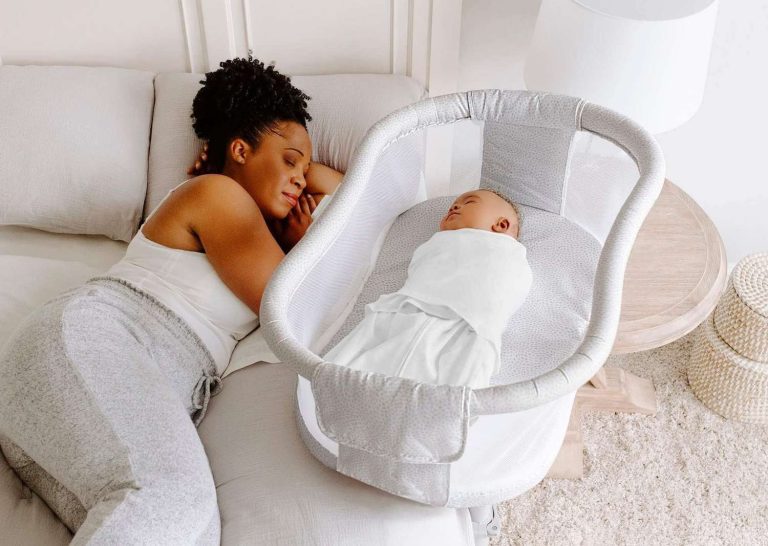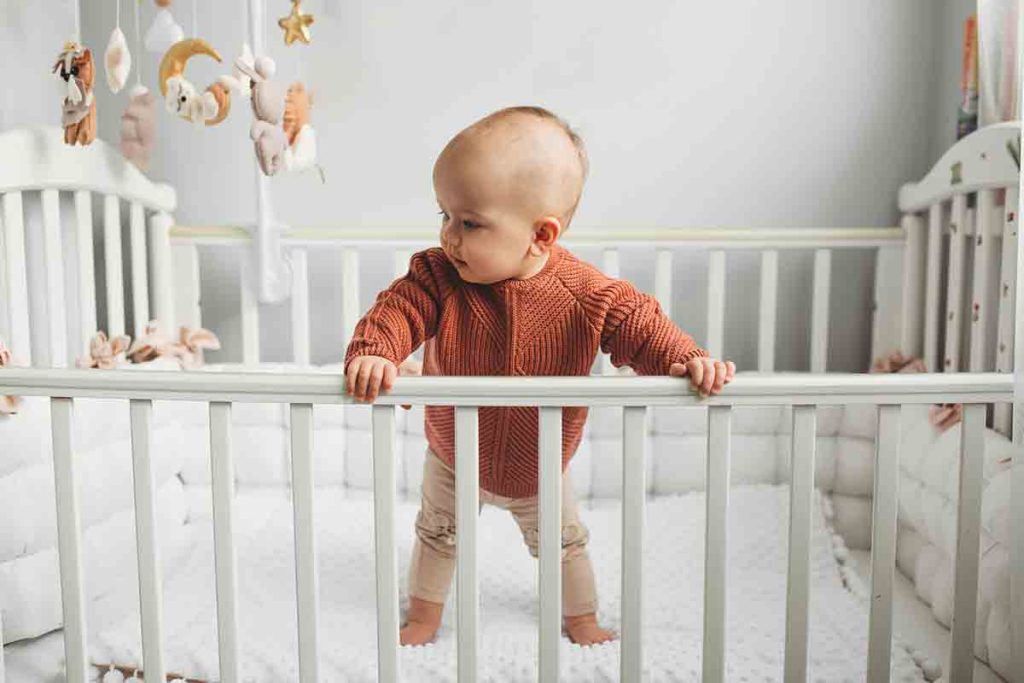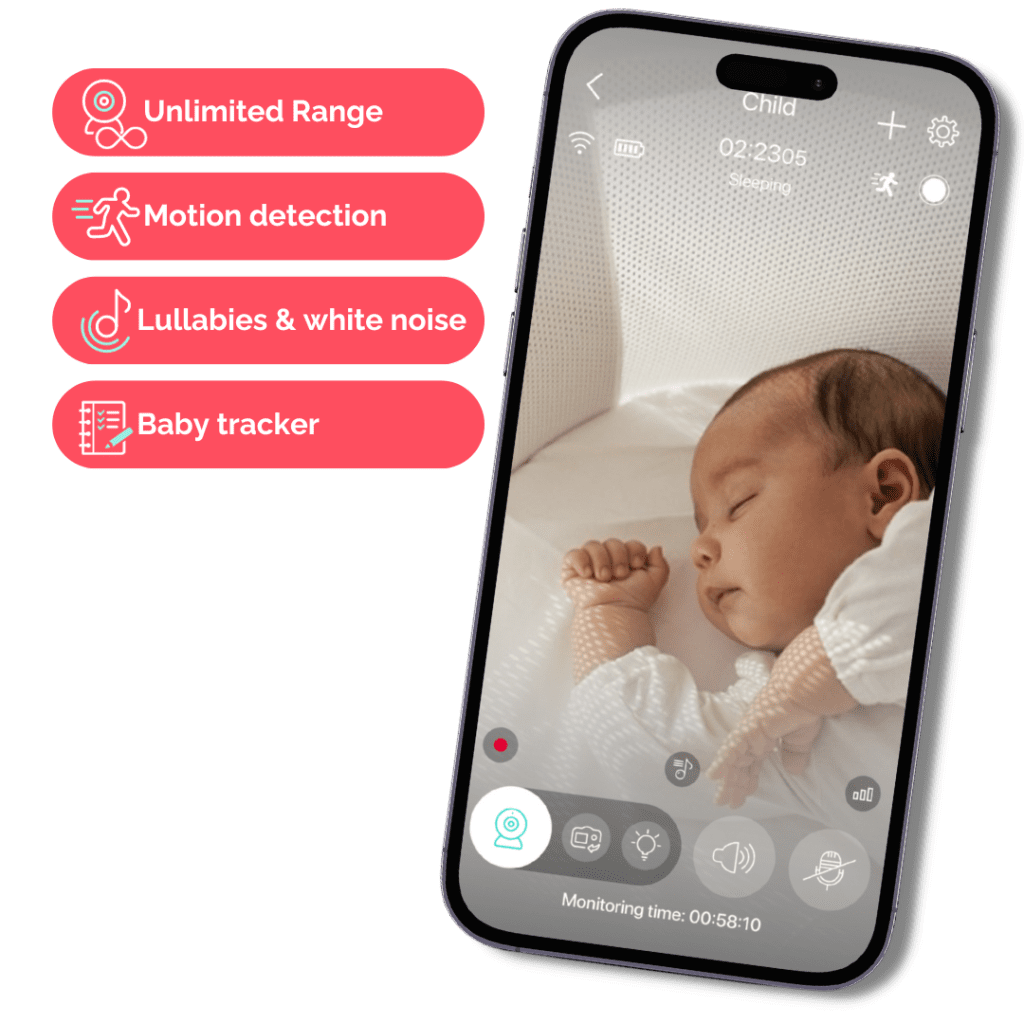
When Should I Move My Baby From The Bassinet To A Crib?
- Created:
7. 3. 2023 - Updated:
15. 2. 2024
Now:
There are two key things that the American Academy of Pediatrics (AAP) keeps emphasizing to newborns’ parents.
First:
No sharing of a bed with an infant to prevent sleep-related deaths.
Second:
Sharing a room with the baby for the first 6 months to 1 year.
But how do you room-share without bed-sharing?
That is where an infant sleep product such as a bassinet and crib comes in.
But how long does a baby sleep in a bassinet, and how do you know when to transition?
That’s what this article is about.
Let’s get into it!
How Long Should A Baby Sleep In A Bassinet?
A baby can sleep in a bassinet until they attain either the bassinet’s weight limit or its age limit, which differs from one model to another. For most babies, this is between 4 and 6 months. A baby should also stop using a bassinet when they show signs of sitting, rolling over, or pushing up on their hands and knees. This is even if they haven’t hit the weight, age, and size limits.
Let’s get a step deeper and discuss each of these indicators in more detail.
Factors that Determine How Long A Baby Can Use a Bassinet
1. The Weight Limit Of The Bassinet
Now:
Every bassinet on the market comes with a weight limit.
The manufacturer usually indicates how much weight the bassinet can safely hold.
For most bassinets, this is usually between 15 and 20 pounds.
There are a few with weight limits extending up to 35 lbs.
When your baby hits or surpasses the weight limit, they shouldn’t use the bassinet any longer.
The baby should transition to a pack ‘n play or crib with a higher weight limit.
Below is a table comparing the weight limit of some of the top-rated bassinettes.
| Bassinet | Weight Limit |
|---|---|
| Halo BassiNest | Up to 20 lbs. |
| Dream On Me Karley Bassinet | Up to 25 lbs. |
| Chicco LullaGo Anywhere Bassinet | Up to 20 lbs. |
| mamaRoo sleep® bassinet | Up to 25 lbs. |
| SNOO Smart Sleeper Baby Bassinet | Up to 25 lbs. |
| Simmons Kids By The Bed City Sleeper Bassinet | Up to 15 lbs. |
| Delta Children EZ Fold | Up to 15 lbs. |
| Mika Micky Baby Bassinet Bedside Sleeper | Up to 33 lbs. |
Note:
The manufacturer determines the weight limit of their bassinets.
This is after a series of tests to identify the weight that would damage the bassinet.
If you go over the weight limit suggested by the manufacturer, you and the baby could get hurt.
While the government authorities don’t verify the weight limits, manufacturers are usually very careful with these tests.
Read the manufacturer’s weight, age, and size information carefully.
2. The Age Limit Of The Bassinet
Sometimes, the manufacturer will also include the age limit for infants who can use the bassinet.
This is usually accompanied by the bassinet’s weight and size limits. The manufacturer assumes that by that age, the baby will have outgrown the bassinet.
However, there is usually a possibility of error. This is because some babies hit their milestones earlier than others.
Only use the weight limit if the baby hasn’t attained the weight or size limit.
Below is a table showing the average weight of boys and girls within the first year. This data is derived from the CDC’s boys’ and girls’ growth charts.
| Age Months | Median weight for boys | Median weight for girls |
|---|---|---|
| 1 | 9.875 lb (AAP weight Recommendation) | 9.25 lbs(AAP weight Recommendation) |
| 2 | 12.3125 lb | 11.25 lbs |
| 3 | 14 lbs | 12.875 lb |
| 4 | 15.4375 lb Weight limit of most bassinet starts here | 14.125 lbWeight limit of most bassinet starts here |
| 5 | 16.5625 lb | 15.1875 lb |
| 6 | 17.5 lbs | 16.125 lb |
| 7 | 18.3125 lb | 16.875 lb |
| 8 | 19 lbs | 17.4375 lb |
| 9 | 19.625 lb | 18.125 lbs |
| 10 | 20.1875 lbVery few bassinets go past this point | 18.6875 lbVery few bassinets go past this point |
| 11 | 20.75 lb | 19.25 lbs. |
| 12 | 21.1875 lb | 19.625 lb |
From the table, most babies, both boys and girls, hit 10 pounds within the first and second months.
Boys hit 15 lbs. by the 4th month, while most girls hit 15 pounds by the 5th month. Most boys weigh 20 lbs. by the 10th month.
Mostly:
Bassinets with weight limits beyond 20 lbs are not usually designed for older babies but rather for babies who weigh more than the average.
This is because large babies outgrow the 15 lbs. bassinets in the second or third month.
The CDC chart below shows the average weight of babies within the first year. The different graphs represent babies depending on their birth weight.
Below is a table showing five bassinets and their age limit.
| Bassinet | Age limit | Weight limit |
|---|---|---|
| RONBEI Baby Bassinet | newborn to 6 months | 20 lbs. |
| Graco DuoGlider, Rascal, 2121561 | 0-4 months | 30 lbs |
| Baby Delight Beside Me Dreamer Bassinet | Up to 5 months | 20 lbs |
| Halo Baby Flex BassiNest | Up to 5 months | 20 lbs. |
| Delta Children Rocking Bedside Bassinet | 0-5 months | 15 lbs |
| Mika Micky Baby Bassinet | Birth to 5-months | 33 lbs. |
Remember the rule:
Transition the baby to a crib when you observe just one sign. This is either
- Hitting the weight limit
- Attains the age limit
- Hitting a developmental milestone
Let’s now discuss the developmental milestones that call for a transition to the crib, no matter whether the baby has hit the bassinet’s age or weight limit.
3. Development Milestones
Now:
From the moment a child is born, the journey of life on earth begins.
This journey happens through small, noticeable, and sometimes unnoticeable milestones.
There are a few of these milestones that, as a parent, you can check to know when your child should transition from the bassinet.
1. The Baby Is Showing Signs Of Rolling Over
One milestone that signifies the end of bassinet use is when the baby starts to roll over. Rolling over is usually their first complex body movement.
While the CDC assigns this developmental milestone to the 6th month, some babies can start rolling as early as the 4th month.
For instance, MedlinePlus assigns rolling front-to-back milestones to the fourth month.
Since you don’t want to wait until the baby is rolling over, you should look for signs that rolling is on the horizon.
Signs that the baby is about to start rolling over include
- Kicking their legs
- Swimming with the arms
- Rocking on their stomach
- Lifting and supporting their chest longer when in tummy position
A 7-sec video by CDC showing a baby rolling over
2. Starts Pushing Up On Their Hands And Knees
Another milestone that signifies the transition from the bassinet is when the baby starts pushing up on their hands and knees.
This push-up position helps the baby strengthen their neck and back muscles.
These movements are usually a sign that the baby is about to start crawling. Since pushing up on hands and knees is an advanced tummy position skill, it happens from the fourth month.
Note:
The CDC has taken crawling off its updated list of developmental milestones, along with another 215 milestones.
What this means is that it’s not a must for the baby to crawl. The updated milestones are designed in such a way that if the baby misses a milestone, you should seek an expert’s opinion.
3. Maintaining A Sitting Position When Put in Such A Position
The moment your little one can sit, either with a little help or unassisted, it’s time to move out of the bassinet.
According to the CDC, 75% of babies can sit when supporting themselves with their hands by the 6th month. By the 9th month, the baby should sit and support themselves independently.
Remember, a 4- to 6-month-old baby can only sit when put in a sitting position. So, you will need to put the baby in a sitting position to assess if they can sit.
A baby can only sit if they have good head control.
Why should a baby transition to the crib the moment they start showing signs of rolling, crawling, and sitting?
Now:
The moment that a baby starts rolling, moving, or sitting, the risks of tipping the bassinet increase.
This would occur when the baby moves to one end, altering the center of gravity of the bassinet, and the baby may fall off the bassinet.
5. When The Space Seems Limited
Now:
While the average birth weight of most babies in the US is 7.5 lbs, some babies are born weighing up to 9.5 lbs with a height of up to 22 inches.
At birth, these babies (the 98 percentile) are almost hitting the 10 pounds AAP weight recommendation. Large babies will surpass the 15-20 pound weight limit in just a few weeks.
For large babies, there will be very little space left in the bassinet. This is unlike the 2 percentile babies, who are born weighing slightly over 5 lbs.
When there is very little space, the baby may accidentally wake up when they hit the bassinet sides.
When they start moving their feet, they will often start hitting on the sides. They will also start pulling on the sides of the bassinet.
6. Whenever You Think It’s Time
As a parent, you often use intuition even without knowing it.
You are blessed with the gut feeling of what is right for your baby.
What do I mean?
Even if the baby has not hit the weight, size, and age limit of the bassinet, transition to a crib whenever you “feel” it’s time.
Look at your baby and how they are behaving in the bassinet, and see if there is a risk of the baby falling out of the bassinet.
Remember:
This only applies to the transition from the bassinet when the baby hasn’t reached the manufacturer’s recommendations.
Don’t be tempted to surpass the weight and age limits, even if it feels right.
7. If The Baby Won’t Sleep In The Bassinet
Sometimes:
You will get one of the best rated bassinets, but your baby may refuse to use it.
Some babies will vehemently cry anytime they are put in the bassinet.
While there are a few things you can try, like patting the baby when putting them down. Or putting them briefly on the side, sometimes these tricks don’t work.
I’ve heard parents say their babies didn’t use their bassinet, for this reason. If your baby seems to hate the bassinet, try a pack n’ play or transition to a crib.

American Academy of Pediatrics (AAP) Recommendation
According to the American Academy of Pediatrics (AAP), the baby should transition to the crib after one month or by the time they are 10 lbs. in weight.
The organization has been at the forefront of advocating and teaching safe sleep. This is because every year, 3500 sleep-related infant deaths are reported.
The surprising thing about these sleep-related infant deaths is that they occur before the 6th month when most parents use bassinets.

What Is The Issue With Bassinets? And How Safe Are They?
Now:
Infant sleep products are becoming heavily regulated.
Beginning in mid-2022, bassinets and cradles are required by law to meet federal safety standards to enhance their safety.
This is because every year, about 3500 sleep-related infant deaths are reported. While there was a very impressive decline in the 1990s, the number of deaths has stagnated in the last two decades.
These deaths are caused by either the sleeping product itself or improper use of the product. To reduce these deaths, the AAP recommends several things, including:
- Supine positioning
- Use of a firm sleep surface
- Use of a non-inclined sleep surface
- Room sharing without bed sharing
- Avoidance of soft beddings
What Do Babies Sleep In After The Bassinet?
When your baby has outgrown the bassinet, below are the best sleeping products for them.
1. Crib
The majority of parents transition their babies to the crib after they have outgrown the bassinet.
Unlike bassinets, which are usually placed in the parent’s bedroom, cribs are mostly put in the nursery.
A crib can also be put in the bedroom if there is enough space. This comes in handy when you want to share a room with the baby up until they are 1 year old.
Cribs are more stable and heavier than bassinets.
2. Pack-n-play
Another sleeping product to use after the bassinet is a pack-n-play, which is also called a playard or playpen.
Just like bassinets, pack-n-plays can also be used from birth. Unlike bassinets, which mostly have a weight limit of between 15 and 20 lbs, most pack-n-plays have an average weight limit of 30 lbs.
This means, unlike bassinets that are only recommended for use up to the sixth month, pack-n-plays can be used for up to two years.
They are slightly bigger than bassinets but smaller than cribs.
Caution:
There are several other sleep products, such as co-sleeper and bedside sleepers. However, the AAP does not recommend them.
Final Tip: Annie Baby Monitor – Your Watchful Companion in the Nursery
Watching over your little one when they start sleeping on their own is important.
You can easily do that by placing a monitor in their nursery. With Annie’s real-time video and audio monitoring, as well as cry and motion detection, you can always stay connected with your child, which will give you peace of mind and give you peace of mind.

Looking for a top-notch baby monitor? Look no further than Annie Baby Monitor. It’s the perfect solution for keeping tabs on your little one. Check it out now.
Conclusion
There are several factors that determine how long a baby should use a bassinet. For the child’s safety, the baby should transition to a crib when any of the following happens:
- Attains either the bassinet’s weight or age limit.
- When the baby starts rolling or pulling by their hands or legs
- If there is no space to stretch their hands and legs
- When the parent thinks it’s time
For most babies, this is usually between the 2nd and 6th month, depending on their growth and development.
Frequently Asked Questions on How Long Babies Should Sleep in a Bassinet
When you see any of the following signs, your baby has outgrown the bassinet:
– When the baby starts showing signs of rolling to the side or back
– When there is very little space left in the bassinet
– If the baby is pulling on the sides
– When the baby surpasses the bassinet’s weight, age, or size limit
– If the baby can sit
There are a few things you can do to make the transition to a crib easier:
– Find a way to let the baby get used to the crib in advance. For instance, let them play in the crib.
– Bring some of the items from the bassinet, such as the sheets.
– Bring the crib into the bedroom. That’s if there is space.
– Start the transition earlier. For instance, let the baby take naps in the crib even when using the bassinet.
– If the crib is in the nursery, spend more time there.
Yes. Bassinets are safe for both day naps and night sleep provided the baby hasn’t outgrown the bassinet.
For the first 6 months, newborns sleep 70% of the day. About 17 hours during the first two months and 15 hours by the time they are 6 months old.






